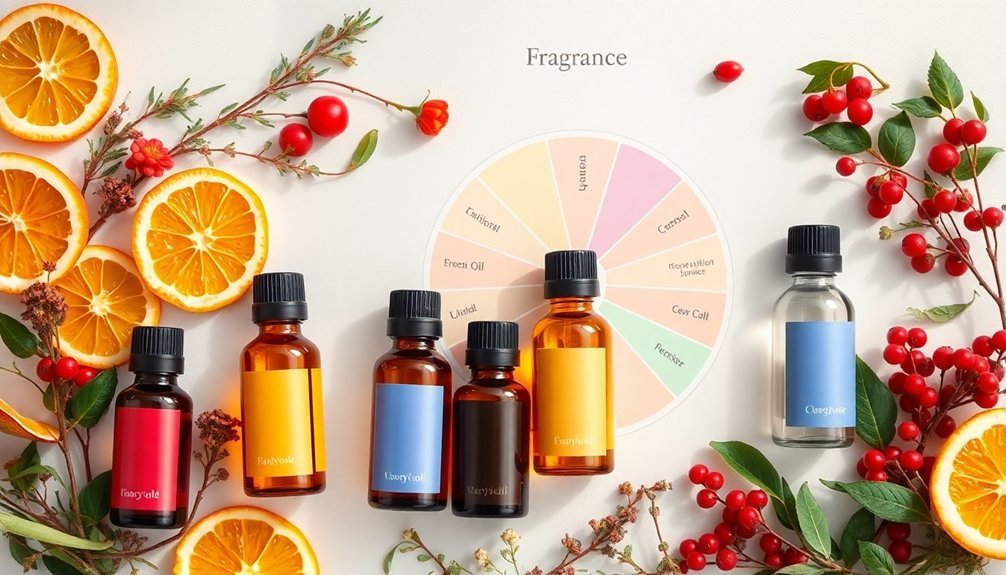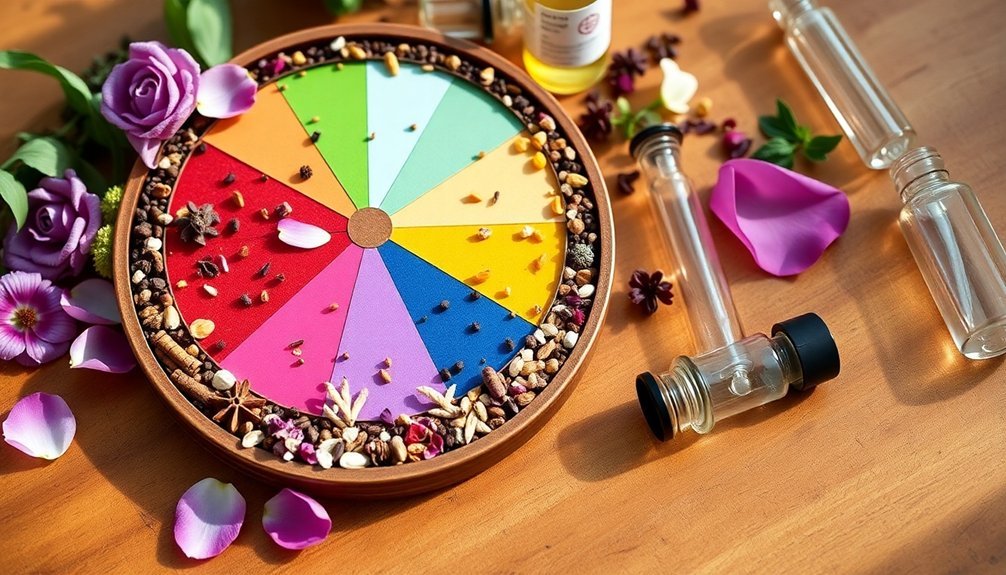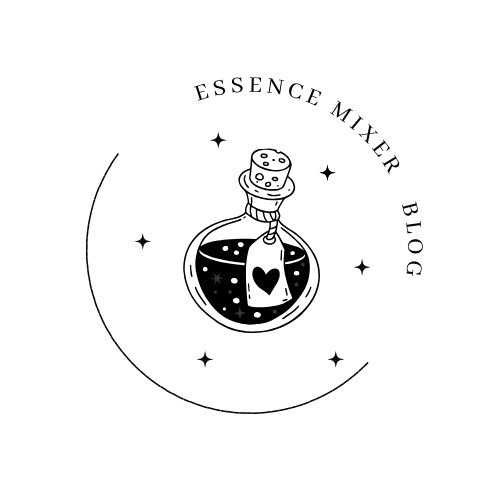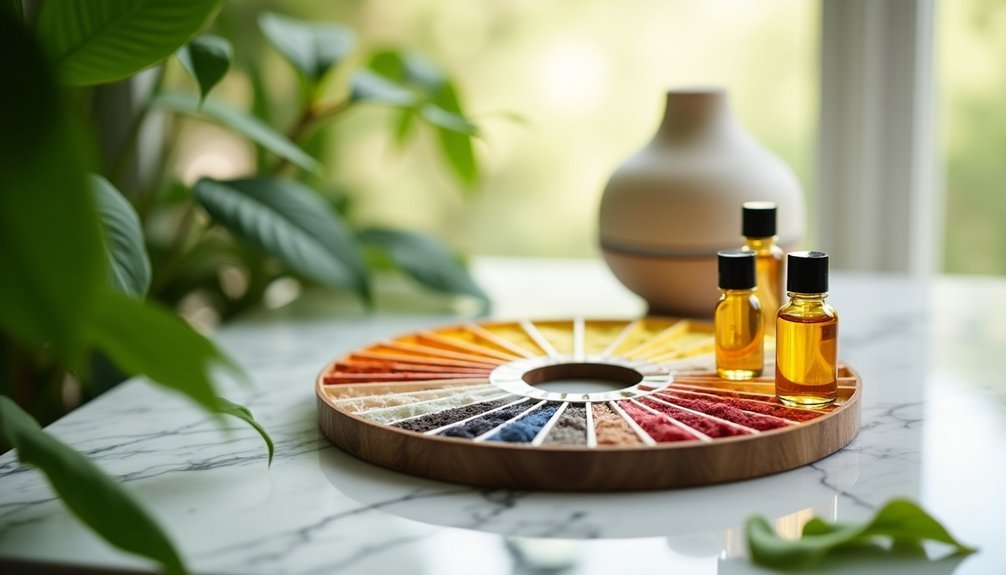Mix your perfect scent by understanding the fragrance wheel's four main families: Floral, Amber, Woody, and Fresh. You'll want to follow the basic 30-50-20 ratio for top, middle, and base notes while pairing complementary scents like floral with woody or citrus with amber. Store your creations in dark glass bottles and give them time to mature. Master these fundamentals, and you'll reveal endless possibilities for creating signature fragrances.
Understanding the Basic Structure of the Fragrance Wheel

When exploring the world of fragrances, you'll find the fragrance wheel to be an essential organizational tool that simplifies scent classification. Developed by Michael Edwards in 1992, this circular diagram breaks down perfumes into four main scent families: Floral, Amber (Oriental), Woody, and Fresh.
The wheel's clever design places similar fragrances next to each other, while contrasting scents appear on opposite sides. This arrangement helps you understand how different notes relate and complement one another.
For example, if you enjoy woody notes, you'll find similar scents in adjacent families, while floral notes might offer an interesting contrast. You can use this knowledge to experiment with fragrance combinations, whether you're looking to layer scents or find your signature perfume blend.
Essential Scent Families and Their Characteristics
You'll discover four primary fragrance families on the wheel: Floral, Amber, Woody, and Fresh, each offering distinct aromatic signatures that shape modern perfumery.
Within these families, you can explore complementary notes like jasmine paired with vanilla in floral-amber blends, or cedar mixed with citrus in woody-fresh combinations.
Understanding these essential groupings helps you identify which scent combinations work harmoniously together, whether you're selecting a personal fragrance or creating a custom blend.
Primary Fragrance Groups Explored
The four primary fragrance families serve as the foundation for understanding and categorizing all perfumes: Floral, Amber (Oriental), Woody, and Fresh.
You'll find that floral scents capture the essence of blooming gardens with jasmine and rose notes, creating an enchanting aroma that's both feminine and timeless.
The amber (oriental) family delivers rich, seductive blends featuring vanilla and cinnamon, perfect for those seeking warm, luxurious fragrances.
If you're drawn to earthy tones, the woody family offers comforting aromas of sandalwood and cedar, providing a sophisticated depth to any scent.
For a crisp, energizing experience, the fresh family combines citrus, oceanic, and herbal notes, making it particularly popular in men's fragrances.
Each family has distinct subfamilies that allow for endless creative combinations.
Identifying Complementary Scent Notes
Understanding complementary scent notes begins with mastering the essential characteristics of each fragrance family and their natural pairings. When you're selecting complementary scents, you'll find that floral notes combine beautifully with woody undertones, creating a balanced and sophisticated fragrance.
Each fragrance subfamily offers unique opportunities for blending – amber's warm vanilla notes pair exceptionally well with rich florals, while fresh citrus elements can brighten woody bases.
To create harmonious combinations, start with your preferred fragrance family and explore adjacent categories on the wheel. For instance, if you love fresh scents, you might experiment with light florals or crisp woody notes.
Remember that complementary scent pairings often work best when they balance each other's intensities, such as matching light, airy notes with deeper, anchoring elements.
Top, Middle, and Base Notes Explained

You'll reveal the secrets of fragrance blending by understanding how top, middle, and base notes work together to create your signature scent.
When layering your blend, start with bold base notes like vanilla or musk, then build up through floral or fruity middle notes, and finish with light, fresh top notes that'll make an immediate impact.
The key to successful combinations lies in balancing these three layers while considering how they'll interact with your unique skin chemistry.
Layering Your Signature Blend
Creating your signature fragrance blend starts with mastering the art of layering three distinct note categories.
Begin by applying your chosen base notes first, as these deep, rich elements like vanilla and musk will anchor your unique scent throughout the day.
Next, add your middle notes, which typically feature florals or spices that'll define your fragrance's character while bridging the gap between other layers.
Finally, top off your blend with lighter, volatile ingredients that'll create an immediate impression. These top notes might include citrus or bright floral elements that'll evolve as they fade.
While layering your signature blend, remember that each note category serves a specific purpose in your fragrance's journey – from the initial burst of scent to the lasting impression that lingers on your skin.
Essential Note Combinations
The art of fragrance composition revolves around three distinct note categories that work in harmony to create a complete olfactory experience.
You'll first encounter top notes, which deliver an immediate burst of lighter scents like citrus or herbs, setting your initial impression within the first half hour.
As these fade, middle notes take center stage, revealing the fragrance's true personality through floral or spice elements that'll last several hours. Your scent placement strategy should focus on these heart notes, as they bridge the composition together.
Base notes are your fragrance foundation, providing rich, deep elements like vanilla, musk, or woods that linger longest on your skin.
Understanding this three-tier structure helps you create balanced blends that evolve beautifully throughout the day, ensuring your signature scent tells a complete story.
Creating Balanced Blends With Complementary Notes
Mastering complementary notes on the fragrance wheel opens up endless possibilities for crafting balanced, sophisticated scents.
When you understand how to pair opposing notes, you'll create a fragrance that's both complex and harmonious. Complementary notes work together by enhancing each other's best qualities while creating depth and intrigue.
Here's how to blend complementary scents effectively:
- Start with floral and woody pairings to achieve a perfect balance of freshness and warmth.
- Mix citrus with amber to create vibrant fragrances that maintain rich undertones.
- Experiment with unexpected combinations like spicy and marine notes.
- Use the fragrance wheel as your guide to identify opposing scent families.
Your fragrances include more dimension when you strategically combine these contrasting elements, resulting in well-rounded scents suitable for any occasion.
Mastering Simple Two-Note Combinations

You'll find reliable success by pairing adjacent notes on the fragrance wheel, such as floral with fruity, or by matching opposites like citrus with amber for dynamic contrasts.
To create a balanced two-note blend, select one dominant note and pair it with a complementary supporting note that enhances its qualities – like combining fresh green notes with warm woody undertones.
Let your fragrance wheel guide you through experimenting with different combinations on your skin, paying attention to how the scents evolve together over time.
Complementary Pairs That Work
When creating custom fragrances, understanding complementary pairs can transform your blending skills from basic to sophisticated.
By selecting scents from opposite ends of the fragrance wheel, you'll discover how contrasting notes can create harmonious and complex aromas.
Here are proven complementary pairs that'll elevate your fragrance game:
- Citrus + Woody: Combine fresh lemon with deep sandalwood for an energizing yet grounded blend.
- Floral + Aromatic: Mix rose with rosemary to achieve romantic freshness.
- Light + Heavy: Pair delicate fresh fragrances with rich base notes.
- Sweet + Spicy: Balance sweet vanilla with warm cinnamon for depth.
Experiment with these combinations while staying mindful of balance.
You'll find that opposing scents often create the most intriguing and personalized fragrances, offering both complexity and character to your custom blends.
Choosing Perfect Note Matches
Building on our understanding of complementary pairs, simple two-note combinations serve as the foundation for crafting custom fragrances.
You'll want to focus on pairing complementary top notes and middle notes that create harmony while reflecting your desired mood.
To find perfect matches, consult the fragrance wheel and look for adjacent scent families. You can create an energizing blend by combining citrus top notes with floral middle notes, like lemon and jasmine.
For a cozy atmosphere, try pairing spicy top notes with gourmand middle notes – cinnamon and vanilla work beautifully together.
If you're seeking depth, combine woody top notes like sandalwood with earthy middle notes such as patchouli.
Don't be afraid to experiment with contrasting combinations; an ozonic top note with amber can create an unexpectedly enchanting scent.
Advanced Three-Note Harmony Techniques
Creating sophisticated fragrances demands mastery of the three-note harmony technique, which artfully combines top, middle, and base notes into a balanced olfactory masterpiece.
You'll discover two primary approaches using the fragrance wheel to craft your signature scent:
- Choose kindred notes from adjacent families (like floral top notes with woody middle notes and amber base notes)
- Select complementary notes from opposite families (such as citrus top with spicy middle and gourmand base)
- Test combinations on your skin to observe how they interact
- Allow time for the scent to evolve, revealing the full harmony of your creation
Seasonal Mixing Formulas for Year-Round Appeal

To achieve year-round appeal in your fragrance collection, mastering seasonal mixing formulas lets you adapt your scents to nature's changing moods.
Fragrances are often described differently across seasons, with spring calling for jasmine and cherry blossom mixed with peach and citrus notes.
Summer scents that complement warm weather blend marine notes with fresh citrus, creating a breezy, beach-inspired atmosphere.
As autumn arrives, soft oriental notes emerge through amber and spice combinations, while woody oriental elements shine in winter formulations.
You'll want to incorporate deep, musky bases like vanilla or sandalwood during colder months, paired with aromatic pine or herbs for depth.
Crafting Signature Scents Using the Wheel
When designing your own distinctive fragrance, the fragrance wheel serves as an intuitive compass for combining complementary scent families. Your signature scents can emerge through strategic combinations that make a lasting impression.
- Start with the neighbor technique by selecting your favorite scent family and exploring adjacent notes that make for naturally harmonious blends.
- Create dynamic contrasts using the opposite technique, pairing your preferred aromatic fragrance with its counterpart across the wheel.
- Apply the triangle method to develop complex scents by selecting three subfamilies that form a triangle on the wheel.
- Layer your chosen combinations with top, middle, and base notes to guarantee your blend evolves beautifully throughout the day.
These wheel-based techniques help you craft unique compositions that reflect your personality while maintaining professional fragrance principles.
Natural vs. Synthetic Ingredient Pairings

Understanding the interplay between natural and synthetic ingredients brings a new dimension to fragrance wheel formulations. You'll find that natural ingredients provide complex, evolving aromas from plant and animal sources, while synthetic ingredients offer consistency and staying power in your creations.
When you're crafting your signature scent, consider how these elements blend well together. Natural ingredients deliver authentic depth and character, but they're often volatile and can fade quickly.
That's where synthetic ingredients step in, offering stability and predictable performance while supporting sustainability by reducing the need for extensive natural harvesting.
You can achieve the perfect balance by pairing natural citrus notes with synthetic fixatives, or combining authentic floral essences with synthetic amplifiers.
This approach guarantees your fragrance maintains both authenticity and longevity while meeting safety standards.
Fragrance Intensity and Longevity Tips
Mastering fragrance intensity and longevity depends on several key factors, from concentration levels to application techniques. Understanding these elements will help you maximize your scent's staying power and impact throughout the day.
For ideal fragrance intensity and lasting impression, follow these essential tips:
- Choose higher concentration formulas (like parfum at 20-30%) over lighter options for extended wear.
- Apply your scent to pulse points where your body heat will naturally diffuse the fragrance.
- Pay attention to base notes containing vanilla, musk, or woods, as they're vital for anchoring your scent.
- Consider environmental factors when applying – warmer, more humid conditions will intensify your fragrance.
Remember that your skin type affects longevity; if you have dry skin, you'll need to reapply more frequently than someone with oily skin.
Troubleshooting Common Mixing Mistakes

Even with proper knowledge of fragrance intensity, mixing mistakes can derail your custom scent creation. To avoid common pitfalls, don't combine multiple strong fresh notes, as they'll compete for dominance and create a muddled impression.
Instead, balance your blend by pairing soft floral elements with deeper, lasting base notes.
Watch out for incompatible scent families – if you're working with sweet notes, avoid mixing them with sharp marine fragrances.
Always test your combinations on skin rather than relying on bottle sniffs alone, as body chemistry can greatly alter the final result.
Keep a detailed log of your mixing experiments, noting which combinations work and which don't. This documentation will help you identify patterns and prevent repeating unsuccessful blends in your future creations.
Professional Blending Ratios and Measurements
Professional perfumers rely on time-tested ratios to create balanced fragrances that evolve beautifully on the skin. The industry standard for professional blending ratios follows a proven formula: 30% top notes, 50% middle notes, and 20% base notes.
You'll need precise tools to achieve accurate measurements when working with essential oils and fragrance compounds.
Here's what you'll need for precise blending:
- A digital scale for measuring ingredients in grams
- Pipettes or droppers for small-batch accuracy
- Testing strips to evaluate scent development
- A storage container for 48-hour maceration
When you're working with these tools, you'll maintain consistency in your fragrance creation.
Remember to test your blend at different stages using the strips – this helps you fine-tune the scent before finalizing your formula.
Storage and Aging Best Practices for Mixed Fragrances

After you've perfected your blend ratios, proper storage and aging techniques will determine the longevity and quality of your mixed fragrances.
To protect your creations, store them in dark glass bottles that shield against harmful UV rays and keep them tightly sealed to prevent evaporation.
Choose a cool, dark storage location away from bathrooms or other humid spaces where moisture could compromise your blends.
You'll want to avoid areas with direct sunlight or heat exposure, as these elements can quickly degrade your carefully crafted scents.
Don't rush to use your fragrances immediately after mixing.
The aging process is essential – allow at least a few weeks for the scent compounds to mature and blend thoroughly.
This patience will reward you with a more refined and harmonious fragrance profile.
Frequently Asked Questions
What Is the 30 50 20 Rule for Perfume?
You'll create a balanced perfume by following the 30-50-20 rule: use 30% top notes for first impressions, 50% middle notes for the heart, and 20% base notes for lasting depth and richness.
What Is the Ratio for Mixing Fragrance Oils?
You'll want to blend your fragrance oils using the standard 30-50-20 ratio: 30% top notes, 50% middle notes, and 20% base notes. For stronger scents, try adjusting to 20-40-40 instead.
What Does the Fragrance Wheel Method Do?
The Fragrance Wheel Method helps you categorize and match scents by organizing them into related families. You'll find complementary fragrances by choosing adjacent families or create unique combinations by selecting opposite scent categories.
How Do I Know What Scents Go Together?
You can identify matching scents by using the fragrance wheel – pair similar notes together, try opposite scents for contrast, or create triangular combinations. Always test blends on your skin for the best results.
In Summary
You're now equipped to create unique, personalized fragrances using the fragrance wheel as your guide. Start with simple two-note combinations, then gradually experiment with more complex blends as your confidence grows. Remember to maintain proper ratios, store your creations correctly, and allow time for aging. Whether you're mixing for personal use or gifting, you'll find endless possibilities in the art of fragrance blending.





Leave a Reply